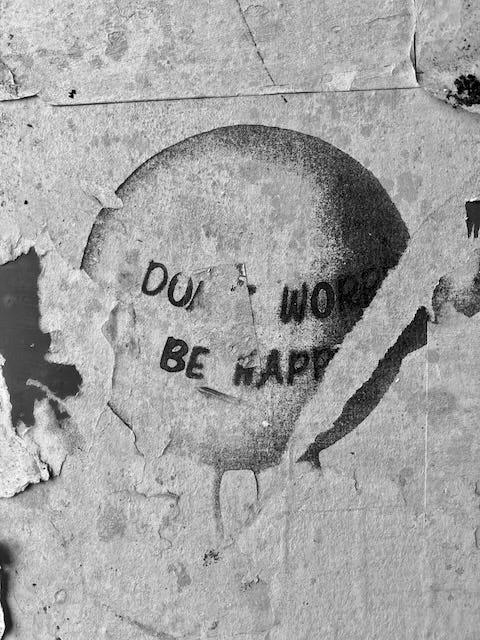Creating a Picture: Your Emotional Fluency
Take a moment to think about, write down, or consider the emotions that you feel on a daily basis. Identify your comfortable emotional range. By comfortable emotional range I mean the emotions you are willing to feel and what intensity you allow yourself to feel these emotions.
Take a moment to be honest about what emotions you do not let yourself feel, refuse to feel, or push away as soon as you feel them. Imagine all the emotions you could possible feel or that you know exist for other people. Identify your deficient emotional range. By deficient emotional range I mean the emotions you are unable to feel, cannot get in touch with, or will not go into.
Use your understanding of all possible emotions to draw a line (in your head or on paper) and fill this line up with the emotions you can identify. Fill one side of the line with your comfortable emotional range. The emotions you know how to feel and let yourself feel on a regular basis. Once you’ve written all those down, Fill the other side of the line with your deficient emotional range. Any emotion you can imagine but do not know how to feel or will not allow yourself to feel is your deficient emotional range.
Imagine yourself on this line with one side of you being the emotions you are comfortable with and the other side of you being the emotions you are deficient in being able to feel. Where do you stand in reference to this line? The picture that you get in your head or on paper represents your emotional fluency.

Information abounds in regards to emotions. You can learn about primary and secondary emotions. You might read that there are only five true emotions - sad, mad, glad, scared, or numb. You may believe that anger is not a “true” emotion (normally believed in people who aren’t comfortable owning it as an emotion). I myself tell people that “FINE” is an acronym for fucked up, insecure, neurotic and emotional. Fine is NOT an answer to the question, “How are you feeling?”
In reality, emotions are complex and…controllable. When we are triggered, we default to feeling the feelings that we are comfortable feeling. An inability to have emotional fluency amongst all emotions, regardless of how they are categorized or understood, creates stagnation and piling.
To have a life that is full of the sensation of aliveness, emotional fluency is a required language to embody. An alive life is not about feeling good. It’s about feeling. Period.
I personally really can’t get behind any guru, teacher, or wise person who speaks about emotions as something to be transcended or avoided. We as humans live on this planet to be fully human. Humans have a huge range of emotions that they get to experience. Lucky us. We need to learn how to feel all of our emotions and allow them to point us in the direction towards experiencing our full human reality. I believe if a person is teaching me how to get above my emotions, they are pushing me into spiritual bypass. It’s a personal red flag for me.
I also know for myself and others that emotions and spiritual bypass represent a dual edged sword. It is a bypass to only focus on the positive and avoid the negative. It is a bypass to habitually avoid any emotion. It is also a different kind of bypass to get caught up in the negative emotions that create depression or cut us off from the ability to feel the positive. To learn how to not be hurt by this sword, we have to develop emotional fluency.
Speaking to an embodied emotional self is to have a willingness to to present to our own complex humanity.
Defaulting into An Emotion

To consider the concept of emotional fluency, there needs to be a personal exploration of default emotions. Comfort with only a select range of emotions means that when we get triggered, uncomfortable emotions aren’t felt. They get swept into the current of what we allow ourselves to feel. All emotions merge into what can feel or the uncomfortable emotions get suppressed. This process creates an internal rigidity as we seek to keep what we do not want to feel out of our consciousness. It also, of course, causes emotional deficiency. Eventually and inevitably, this kind of defaulting into emotional comfort will create problems.
There are primary emotions that we all have a predilection to feel in a given situation. In an incredibly stressful situation some people are going to get really angry and fight while in that same situation will get numb, scared, or sad. Rarely in stressful situations do we see someone get overly happy BUT there are always those relentless optimists that will turn anything into something positive so, I guess it is true even in relation to the positive.
Defaulting into an emotion means any intense emotional reaction becomes one primary emotion in your system.
We could say that emotional merging begins with emotional default. Whenever we default to an emotion and get caught up in it rather than question why we're feeling it, we are engaging in emotional merging. The thing that's going to happen when we emotionally merge is that we're not just going to remember one experience that's in the moment that’s creating an emotional reaction. Instead, we are going to pile. We are going to start to associate that emotion with familiar feelings and situations in the past.Then that's going snowball. This process is inevitably going to make the emotion that we're feeling too big. It's going to make us feel powerless against it and the situation. It's going to make it so we cannot actually engage with the emotion itself or the situation we are triggered by.
Emotional merging on some level is natural. The reason it's natural is only because we aren't looking at or wanting to be emotionally fluent. We aren't wanting to nuance our emotions. We're wanting to corral emotions into comfortable discomfort. We were wanting emotions to point to a lack of choice or a feeling of being trapped…at least unconsciously. I guess you could call the self sabotage right? Whenever we merge, we merge to make ourselves feel soothed. And in this case, it's ironic that the soothing makes a problem bigger or takes away a sense of choice.
Curiosity, The Unknown, and Risk
It all starts with curiosity. Isn't it interesting how many processes start with curiosity? I really have to appreciate the importance of developing an ability to have open minded curiosity. Without the ability to be curious, there is no growth on a personal level or on a relational level. In the case of emotions we need to be able to ask ourselves, “what else is here?”. It's not about stopping the emotional merging that comes from the impulse to default into our comfortable emotional release process. It's not about preventing our emotional default. It's about expanding into a curious experience of the unknown more.

Questing into emotion is very different than losing the self to an emotion. It involves the unknown. We have to say, “yes default emotion, I feel you, but what else is there that I can't feel?”. We have to curiously explore down into an emotion instead of talking ourselves out of it or letting it be overrode by our default emotion(s). We have to know ourselves well enough to know how we deal with the emotion we feel and try to make a different choice into curiosity.
This choice into questing an emotion is to be kind of like learning to speak another language. Many of you know I'm working on becoming fluent in Italian. Do you know how much I mess up? Do you know how hard it is on the ego to learn a different language 40+ years into life? Fluency involves being willing to not know, to mess up, and to learn from how things go wrong. All of this happens internally with emotions. We may feel like we are feeling the wrong thing or feel scared to try something new. However, we won’t know how to grow unless we try.
The quest into emotional fluency involves curiosity, the unknown, and being open to the risk of messing up or doing it wrong. Anything else? I guess what I want to talk about is that sometimes we become too interested in the emotional story that we receive when we dump ourselves into an emotion. I know that this is kind of a harsh way of talking about how a lot of we experience emotion, but it’s a hard truth I need to share.
We become so self involved when we get into deep emotions. This is especially true of the default one or two emotions we are comfortable with. We get caught up in this tornado of self involved drama. We embrace emotional tunnel vision. We stop being able to see anything but our own story.
To break the cycle and discover something new, we really need to see beyond the story. We need to be able to hear the internal voices that we never seem to be able to hear. We need connection with a new part of our self, that is separate from the story of the emotion and the trauma of the emotion. Sometimes this process is going to be appropriate, balanced, contained. Sometimes this voice is going to be real and grounded. And sometimes the voice we hear is going to be completely blown out and self involved. We won’t know until we try. Risk is present in developing emotional fluency.
Reduce, Renew, Recycle?
When it comes to emotional fluency, recycling is absolutely not environmentally friendly. Neither is reducing! Renewal is where it’s at. Recycling emotions is going into old trauma without healing it. It’s feeling what we know how to feel over and over again without resolution. Reducing is squashing emotion, not letting ourself feel what comes up, telling ourselves that we cannot feel what we feel. Renewing emotions is when we engage with emotions in a way that brings us into a new relationship to them. And I want you to just stop for a second and think. Are you capable of renewing emotional processes?

I personally know the reason that I have transformed so much of my life is through developing emotional fluencty. I understand why people who knew me when I was 12, 17 , 25, or even 35 tell me how much I've changed, how much more vibrant I am, how alive I am. It is because I know how to renew my life through emotions. I know how to utilize emotions to heal. Not wound. Not crush. Grow. Thrive. Become.
I really want you to ask yourself if you understand this concept of emotional renewal. And if you don't, I sincerely ask you to write a comment to me about what you struggle with in regard to emotional renewal so that I can address this concept more specifically in future posts.
The ability to renew emotions is essential to personal transformation.
Secondary Emotions Matter
Secondary emotions are important. Nuanced emotions are essential. Allowing ourselves to actually form a relationship to those primary emotions rely on the ability to withstand and embody secondary emotions. Some of you are going to say you can't help the way you feel right? That is on some level true. Emotional fluency is in no way about controlling how you feel. It's about being open to more than you think you feel. We all know that we create neural pathways in our brain through what we feel, what we think, and how we act. Emotional defaulting occurs because when we have an issue, there's a super highway of neural connection that connects trigger or upset to a default emotion. Emotional fluency needs to be developed outside of being triggered.
Working with developing emotional fluency has to happen when you are not triggered or upset.
Emotional fluency is something that we can develop in our daily lives. Allowing situations that aren't intense to have a non-intense response in the form of secondary emotions. Maybe you struggle with feeling anything but grief or sadness. To develop a relationship to other emotions would require slowing down and recognizing when you get frustrated and letting that frustration grow into a feeling, maybe of being mad or wanting to push someone out of the way or getting angry. If you really struggle with vulnerable emotion and you really enjoy the feeling anger, you would need to notice vulnerability that shows up in your daily life before you shut it down. What is shut down and unfelt comes up often in daily life but is too often ignored.
It really takes a curious and open mind to develop emotional fluency. Secondary emotions are the bridge needed to develop a full rapport of primary emotions. Connection to those secondary emotions happens in normal every day life. Being able to feel nuances of happiness, nuances of sadness, nuances of fear, and nuances of anger will increase your ability to recognize those larger primary emotions as they show up in a triggered situation.
The Power of Emotional Coherence
All the time people talk to me about how they say, “No.” it isn’t respected or that clear statements of need aren’t met with a clear response. Emotional coherency occurs when what is being felt matches what is being said. We cannot have emotional coherence without emotional fluency. We become emotionally fluent so that we can relate with more self clarity. Other people feel safer to us when they are emotionally coherent. We feel safer to others when we are emotionally coherent.
When we are emotionally fluent, we can create emotional coherency because we know how to be honest to our bodies toward what our bodies are feeling and extend that outwards when necessary to others.
I happen to believe that the world as a whole right now needs the healing potential of emotional coherence. Chaos is being created and felt everywhere. People are lost to themselves. The antidote to what is being brought to life that's toxic in our environment is emotional coherence.
Of course, there is no spiritual bypass in emotional coherence. I am not talking about always feeling happy. I'm talking about being able to feel something, name it, and let that allow for a coherency to come into your being. Emotional coherence creates a medium for a deeper acceptance of self. Often coherency simply feels like relief. Flow comes when you admit your own humanity. The less you fight yourself, the less the world has to fight itself. Emotional coherence is the path towards a connected future. It’s the way into embracing all you are meant to be.
Keep reading with a 7-day free trial
Subscribe to mindfullynessa to keep reading this post and get 7 days of free access to the full post archives.



